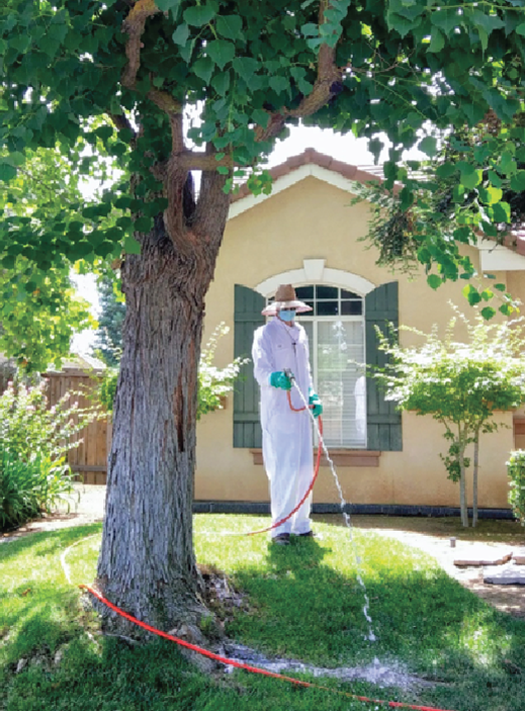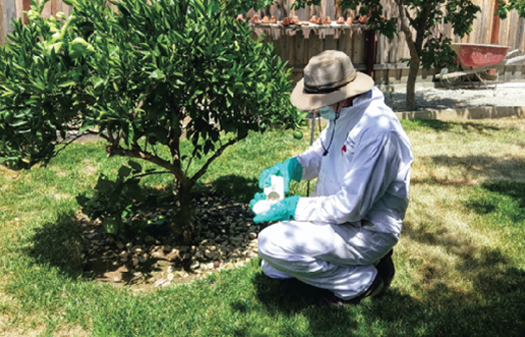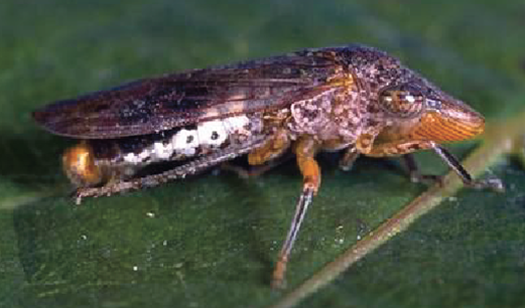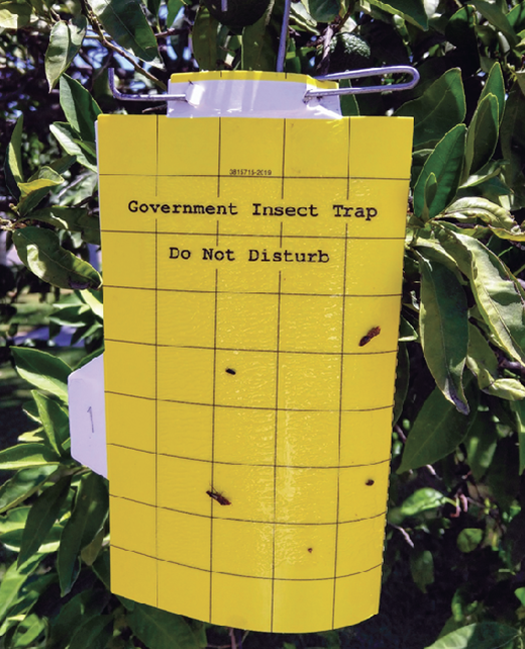Glassy Winged Sharpshooter
Introduction
The glassy-winged sharpshooter (GWSS) insect spreads the bacteria Xylella fastidious, which causes the destructive Pierce’s Disease (PD) in grape vineyards, as it feeds on the interior fluid of many common plants. There is currently no treatment for PD once vines are infected, and they must be removed and destroyed to halt its spread. GWSS was first reported in California in 1994 but probably arrived in the late 1980s. It is native to the southeastern United States and northeastern Mexico. GWSS builds up large populations on a diverse array of host plants, including citrus, and is an aggressive flyer, traveling greater distances than native sharpshooters.
California’s first indication of the severe threat posed by this new disease and vector combination occurred in Temecula, Riverside County in August 1999, when over 300 acres of grapevines infested with GWSS were infected with PD and ultimately destroyed. In order to protect the grape industry from destruction by PD, the GWSS Program is dedicated to the detection and suppression of this destructive pest.
Helpful Links
The GWSS Program’s Four Main Program Areas
Urban and Grid Trapping (Detection) Program
 Throughout the year, Fresno County employs staff to place yellow sticky traps in citrus groves, grape vineyards, citrus packing sheds, and GWSS host plants in residential areas to detect the presence of GWSS outside of the established quarantine zone.
Throughout the year, Fresno County employs staff to place yellow sticky traps in citrus groves, grape vineyards, citrus packing sheds, and GWSS host plants in residential areas to detect the presence of GWSS outside of the established quarantine zone.
When a GWSS is found, the trap is sent to the State Entomology Lab for ID confirmation.
Residential Treatment Program
When GWSS is confirmed found in or near a residential area outside of the established quarantine zone, the residential area is scheduled for treatment of GWSS host plants. This treatment is provided free of charge and helps to control a variety of garden/landscape pests.
 Residences receive an Advance Notification of treatment. Below is a link to the form.
Residences receive an Advance Notification of treatment. Below is a link to the form.
GWSS Residential Treatment Product Labels
GWSS Treatment FAQs
GWSS Program Contact
559-470-8188
GWSS Nursery Program
To facilitate movement of Nursery Stock from GWSS infested or partially infested areas to GWSS Non-infested or partially infested areas, nurseries may operate under Program Regulations if they have not had GWSS found on their grounds. Under program regulations, nurseries follow a treatment schedule with pesticides approved for treating life-stages of GWSS. If the Nursery Premise has GWSS life stage finds, they may still ship to partially infested or non-infested areas under a GWSS Master Permit that requires additional GWSS pesticide treatments prior to every shipment.
Commercial Citrus Treatment Reimbursement Program
To encourage commercial citrus growers to treat for GWSS found in their vicinity, CDFA offers reimbursement funds to commercial citrus growers on a per acre basis when pesticides approved for treating GWSS are applied.
Commercial Citrus Grower Reimbursement Program Contact
559-600-1952


GWSS Frequently Asked Questions
Will these products get into the groundwater?
A study was conducted in 2009 by the California Environmental Protection Agency to check for the presence of Imidacloprid in ground water by testing wells in high use areas in five counties. Thirty-four wells were selected for sampling, based on depth to ground water, soil type, use of Imidacloprid, and well location. No residues of Imidacloprid or its degradates were found in any of the wells tested. The results of this sampling mirror findings of a 2004 study that found no ground water contamination.
Source: CDFA. 2009. Ground Water Monitoring for Imidacloprid and Four Degradates in High Use Areas in California. Click here for information on Ground Water Monitoring for Imadacloprid(PDF, 1MB).
Do I have to be home during the GWSS treatment of my property?
No. If you are not home during the treatment our Treatment Crew Lead will leave a Treatment Completion Notice at your door informing you that they have completed treatment of your property.
What time will the GWSS Treatment Crew be at my residence?
It is difficult for our Treatment Crew to know what time they will be at a residence due to the variable length of time each treatment takes. Some treatments take only five minutes, and some take over an hour. Due to this variability, we do not give residents treatment time windows during your scheduled treatment date.
Can the Treatment Crew call when they get a couple residences away so I can open gate(s)?
If requested, we will do our best to contact you before the treatment, but due to the variable nature of this program we sometimes will be unable to do so. If the treatment crew is unable to call, they will always honk their horn at any access gate(s) for a few minutes to give you a chance to open any gate(s).
Will these products harm me or my family?
Chemicals used as pesticides or anti-microbials are classified into three categories according to their short-term toxicity:
- Danger – highest toxicity level
- Warning – mid toxicity level
- Caution – lower toxicity level
Merit® and CoreTectTM are Caution labeled products. This classification includes familiar products like RoundUp® Weed and Grass Killer which you may already use around your yard. Both Merit® and CoreTectTM are less toxic than some common household cleaners such as Clorox® Regular Bleach (Danger) and Tilex® (Warning). While reactions to Merit® and CoreTectTM are unlikely, please take precautions.
Please keep windows and doors closed during treatment and keep people and pets away from the area until the product has dried.
Will the GWSS Treatment products harm my pets?
Imidacloprid, the active ingredient in these products, is the same active ingredient in Advantage II® Flea & Tick control for dogs and cats as well as many other small animal flea & tick treatments and should not pose any risk to your pets. Every pet is different and for their safety, please keep them secured during treatment and until the product has dried.
Yards with unsecured dogs will not be treated. Outdoor cats show a strong tendency to vacate the area during treatment and are not considered to be at risk. These products will not be used around grazing animals. Yards with free-roaming pet reptiles will not be treated. Yards with rabbits, birds, or any other domesticated animal will not be treated unless the animal is secured during treatment. These products are toxic to aquatic invertebrates. Plants near or in water features or standing water of any type are not treated.
How long do these products take to dry?
CoreTectTM is a tablet formulation and is buried approximately three inches deep in the soil below citrus trees. There is no drying time associated with CoreTectTM. The drying time of Merit® depends on the weather; on a sunny day with temperatures exceeding 80º F, the dry time is less than 30 minutes. On a cool, cloudy day the dry time may take two hours or more. These are only guidelines; please monitor your property during the weather conditions on your day of treatment.
What other insects do these products control?
Merit® and CoreTectTM will provide control of adelgids, aphids, leaf-feeding beetles, leaf-feeding bugs, leafhoppers, leafminers, mealybugs, pine tip moth larvae, planthoppers, psyllids, royal palm bug, scale, sharpshooters, spittlebugs, and whiteflies for about one year. These products only control insects that feed on plant tissues. This product will not control black flies or mosquitos.
For more information about the GWSS Treatment Program, please contact the GWSS Program Office at 559-470-8188.